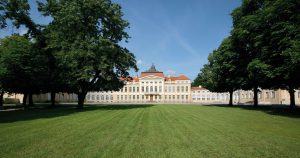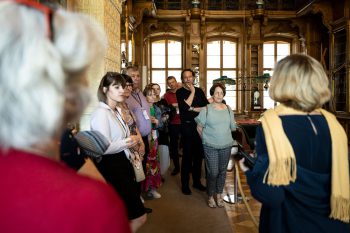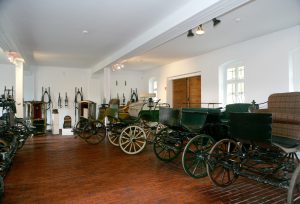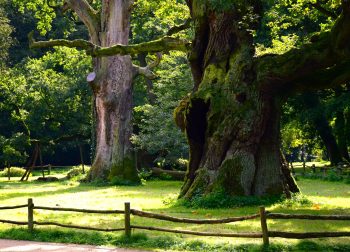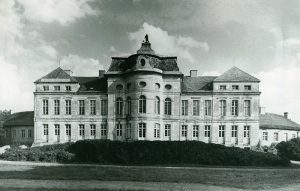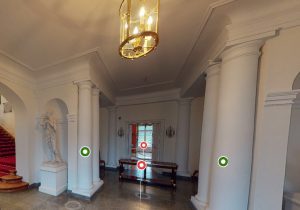An integral part of the mansion in Rogalin, founded by Kazimierz Raczynski in the 1770s, is the garden and the park. Next to the palace, on the western side, lies the rococo garden, a Baroque composition which fulfils its original objective, entre cour et jardin (between the courtyard and the garden). The parterre garden is dotted with conically shaped thuja trees surrounded by rows of ball shaped lindens. At the western edge, the garden is completed by a mound known as Parnassus, from where once stretched a panorama of Warta meadows, which is now obscured by tall trees. The garden is framed by rows of clipped hornbeams. Amongst them at the height of the mound, are oval (garden) cabinets. The composition of the garden is complemented by stone vases and Rococo statues of mythological deities.
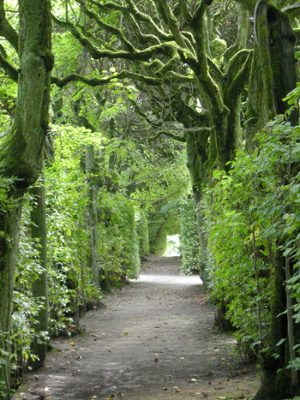 At a later date, the former menagerie (a fenced forest area where wild game was kept), adjacent to the mansion from the south and west, began to be transformed into a landscaped park of sentimental nature. As early as 1788, a “Plan of the wild garden made for JWnej jmci Mrs. General Raczynska” was created, with which the design of the pavilion in the form of a Turkish kiosk, by J. Ch. Kamsetzer, should probably also be associated. At the beginning of the nineteenth century came the water mill in the shape of a wooden Gothic temple, which was one of the essential elements of the romantic park created a little later by Edward Raczynski. It was located within the picturesque backwaters of the Warta, which, together with the remnants of the original oak woods, have become major components of his creation as they connect naturally with the mansion. Nothing is left of the mill-chapel but in the western part of the park there remain monumental specimens of pedunculate oaks (Quercus robur). The most famous among them are Lech, Czech and the even older, Rus, which has been dated to about 700 years (the Rogalin oaks have borne the names of the three legendary Slav brothers since the post-war period).
At a later date, the former menagerie (a fenced forest area where wild game was kept), adjacent to the mansion from the south and west, began to be transformed into a landscaped park of sentimental nature. As early as 1788, a “Plan of the wild garden made for JWnej jmci Mrs. General Raczynska” was created, with which the design of the pavilion in the form of a Turkish kiosk, by J. Ch. Kamsetzer, should probably also be associated. At the beginning of the nineteenth century came the water mill in the shape of a wooden Gothic temple, which was one of the essential elements of the romantic park created a little later by Edward Raczynski. It was located within the picturesque backwaters of the Warta, which, together with the remnants of the original oak woods, have become major components of his creation as they connect naturally with the mansion. Nothing is left of the mill-chapel but in the western part of the park there remain monumental specimens of pedunculate oaks (Quercus robur). The most famous among them are Lech, Czech and the even older, Rus, which has been dated to about 700 years (the Rogalin oaks have borne the names of the three legendary Slav brothers since the post-war period).
The romantic scenery of the park is completed by the antique replica of a church – mausoleum, situated on a lofty cliff at the eastern edge of the mansion. Edward built it in the years 1817-1820 and placed the inscription DIVO MARCELLINO on the front of it, wishing to honour the memory of his cousin, Marcel Lubomirski, one of the fallen in the Napoleonic Wars. The architectural prototype for this historic building was the Roman temple, Maison Carrée, from the first century BC in Nîmes, France. The most modern materials of the time were used in its construction including cast iron, from which the bases and capitals of the columns, the frieze of acanthus leaves the statues of lions and the handles on the door were made. These handles were cast in Rogalin, perhaps by the same Count Raczynski, who was renowned for his versatile talents and interests.
The interior is divided into two parts. The upper part with the Empire decoration was intended by the founder to serve as a church. The lower ancestral mausoleum was dedicated to the resting place of his grandfather, Kazimierz Raczynski and his ancestors, whose ashes were brought from the monastery in Woźniki. Located in the basement, the mausoleum has been designed in the form of a romantic, medieval crypt of Romanesque-Gothic design, inspired by the ancient architecture of Italy, especially Sicily.
The mausoleum is the resting place of many generations of the Raczynski family. Here one can find, among others, Roger Raczynski’s beautiful white marble tombstone, showing his whole body sculpted, the work of A. A. Solomon in 1865. The last male representative of the family and the creator of the Raczynski Foundation, Edward Bernard Earl Raczynski, is also buried here.
Autor: Joanna Nowak, Ewa Leszczyńska


